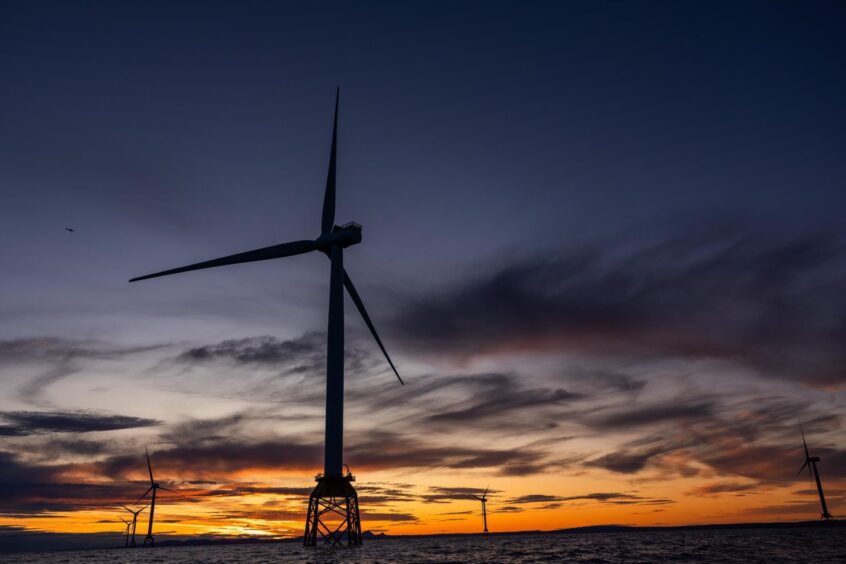
Demand for offshore wind is there – so how we can ensure that all Scottish businesses benefit from the energy transition opportunity now and in the future? Jamie Sansom, team lead of offshore wind at Scottish Enterprise, discusses this important question.
It’s difficult to underestimate the growing global demand for offshore wind – and its potential to transform the Scottish economy.
For me and my team of industry experts at Scottish Enterprise, the key to success is understanding and anticipating what the market will look like in the future, but also ensuring that businesses across Scotland take full advantage of the opportunities that already exist in this vibrant energy transition sector.
The next five to ten years will be a defining time for the Scottish economy, and here at Scottish Enterprise we remain focussed on working with businesses and partners across the country to help deliver economic transformation.
In the face of global economic challenges and constrained public finances, it’s more important than ever that we remain laser-focused on those high-growth markets where we can make the biggest impact, and where companies in Scotland are best placed to compete internationally and achieve their growth ambitions.
The transition from fossil fuels to more sustainable and environmentally friendly solutions has seen the emergence of new and exciting sectors and market opportunities. This makes for a once in a generation opportunity for entrepreneurs and innovators to seize the moment and transform the Scottish economy.
The role of offshore wind in the race to net zero
Offshore wind is one of the energy transition markets that will play a critical part in the global race to net zero.
The UK remains a world leader in offshore wind, accounting for roughly 20 percent of global offshore wind capacity, with 11.3 GW operational.
In Scotland, developers have outlined ambitious plans to invest £29 billion into the ScotWind offshore wind projects, and the Scottish Government has announced £500 million in funding to support offshore wind development and to ensure delivery against their deployment target of 11GW by 2030.
Globally, expenditure in the sector is expected to reach £210 billion in the next decade.
These numbers leave little doubt that the sector will continue to grow exponentially as demand for low carbon technology continues to increase both domestically and internationally.
Let’s be honest though, global gigawatt numbers and phrases like ‘seizing the opportunity’ are a bit nebulous when it comes to informing business decisions.
Businesses tell us they find it more helpful if they have a defined problem to solve, and a tangible project or opportunity to get involved in.
That’s where our offshore wind team comes in. Our mission is to ensure that all Scottish businesses can benefit from the energy transition opportunities that exist right now, as well as those coming, to enable Scottish firms to grow their market share and open up new lines of business.
Identifying routes to market for the supply chain
The key to our success is making sure we have an in-depth knowledge and understanding of both the needs of the industry developers, and the capabilities and specialisms across the supply chain in Scotland.
To give an example, we know that developers are currently looking to build wind farms in Scottish waters.
As part of the ScotWind bidding process, these developers have indicated how much money will be spent in Scotland, the UK, Europe and the rest of the world. The spend is apportioned across development, manufacturing and fabrication, installation and operation.
The largest portion of the planned spend in Scotland is across manufacturing and fabrication, and so the role of our team is to get a strong sense of the specific needs of the developer – and to share that information with companies across the supply chain, to find viable solutions here in Scotland.
Scotland has work to do to establish supply chains capable of producing top-tier components such as blades, cables, floating foundations and the necessary port infrastructure.
That said, we know that businesses operating in Scotland have tremendous heritage and strength in manufacturing and fabrication and in port operations. So, our immediate priority is to do all we can to help companies that want to become part of truly successful and globally recognised supply chains here in Scotland.
Supply chain businesses in Scotland are telling us they need more information about the lower-level components and materials that make up the major components.
They want to know who buys from whom within the tiered supply chain structure.
They want to know volumes and routes to market.
They want to know where to seek wider advice and financial support to ready their business to meet the demands of offshore wind.
To that end, my team has just launched a series of manufacturing factsheets which provide background information for companies wishing to enter the offshore wind supply chain.
Our team of specialists is building a detailed picture of the bills of materials needed to make major components right through the tiered supply chain. Working with the offshore wind clusters and bodies like Scottish Engineering and the Energy Transition Zone, we are populating that picture with companies operating in Scotland which have the capability to make a component or supply a raw material.
The team share knowledge about companies in Scotland that have ambitions to, or can already provide, raw materials and subcomponents into those supply chains. They are making introductions where they can and creating a network of buyer/supplier relationships to help with route to market.
There will undoubtedly be gaps in that supply chain picture, and our first strand of supply chain development is to fill those gaps with inward investors, ambitious indigenous companies or companies with innovations.
This is where the team brings in the wider expertise of Scottish Enterprise, Scottish Development International, Skills Development Scotland and other organisations such as Offshore Renewable Energy Catapult and the Offshore Wind Growth Partnership. This helps to strengthen the performance of companies already supplying the sector and to fill gaps in the supply chain.
This approach has been welcomed by developers and tier 1’s because it aligns well with the work of their procurement package managers.
It’s also been embraced by suppliers across the supply chain as an effective way of promoting their capabilities, and by companies looking for opportunities to diversify into the offshore wind market.
Building relationships across the supply chain
Through our combination of Business Support services and advice, our access to funding and investment, and our industry networks at home and overseas, we can help your business take advantage of the enormous economic opportunities within offshore wind and across all of the energy transition markets.
The more information we have on the supply chain, the easier it becomes for our team of experts to match your business with relevant buyers or identify new opportunities – not only in the offshore wind sector, but in other energy transition markets, such as hydrogen or clean heat.
If you’re a supply chain company, we would encourage you to get in touch with Scottish Enterprise so that we can get a better understanding of your business’ capabilities and expertise.
If you’re a developer, get in touch with Scottish Enterprise so that we can provide an overview of the strengths and capabilities across the supply chain that may appeal to you.
Building these relationships will allow us to make connections, share information and solve problems together.
Get in touch and learn more about Scotland’s energy transition opportunity.
Recommended for you

 © Supplied by Scottish Enterprise
© Supplied by Scottish Enterprise